This is an AI Free Zone! Text created by ChatGPT and other Large Language Models is spreading rapidly across the Internet. It's well-written, artificial, frequently inaccurate. If you find a mistake on Spaceweather.com, rest assured it was made by a real human being. | | |
GEOMAGNETIC STORM WATCH (G1): Minor G1-class geomagnetic storms are possible on Sept. 17th when a CME is expected to graze Earth's magnetic field. The CME was hurled into space on Sept. 14th by the eruption of a magnetic filament in the sun's northern hemisphere. Arctic sky watchers should be alert for auroras this weekend. Aurora alerts: SMS Text
EARTH-DIRECTED SOLAR FLARES: Sunspot AR3429 is crackling with M-class solar flares. This interest-compressed movie from Sept. 15th shows extreme ultraviolet flashes from four eruptions, all Earth-directed:

Pulses of radiation from this sunspot are ionizing the top of Earth's atmosphere, creating a rolling series of shortwave radio blackouts over all longitudes of our planet. Ham radio operators, pilots and mariners may notice occasional loss of signal, especially at frequencies below 20 MHz.
So far none of the explosions has hurled a CME toward Earth. They've all been too brief to lift a CME out of the sun's atmosphere. However, there is a huge magnetic filament snaking around the sunspot group. If continued flaring destabilizes the filament, it could erupt and hurl significant debris in our direction. Stay tuned! Solar flare alerts: SMS Text
A RUSHED, SURPRISE ROCKET LAUNCH: There was no warning. On Thursday night at 7:28 pm PDT, a Firefly Alpha rocket lifted off from the Vandenberg Space Force Base in California. It carried an unusual satellite named "Victus Nox." Stephen Hummel saw the launch more than a thousand miles away at the McDonald Observatory in Texas:
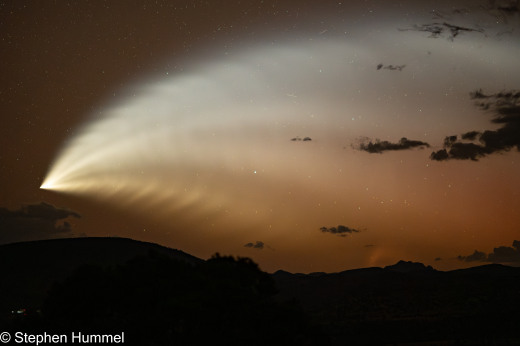
"A bright exhaust cone expanded to cover a large area of the sky during astronomical darkness," says Hummel. "After the cone faded, there was a slight red afterglow" probably caused by the rocket punching a hole in the ionosphere.
Latin for "conquer the night", Victus Nox is a US Space Force experiment, testing the ability of Firefly Alpha to launch a military satelite with only 24 hours notice--a so-called "responsive launch." In the past, typical Defense Department launches took anywhere from two to five years. The last responsive space experiment, the June 13, 2021 launch of TacRL-2, required 21 days.
Alpha Firefly successfully launched Victus Nox only 27 hours after it received a "go" notice. The extra 3 hours was a result of a weather delay. The mini-fridge-sized satellite will now provide "space domain awareness" data to the Space Force.
more images: from Chris Cook of Long Beach, CA; from Carol Kunkis Cohn of Corona del Mar, CA; from Mike Olason of SaddleBrooke, AZ; from Thom Peck of Poway, CA; from Jessica G. Sherva of Tucson, AZ; from Laura-May Abron of Los Angeles, CA
Realtime Space Weather Photo Gallery
Free: Spaceweather.com Newsletter
SOLAR ECLIPSE PENDANT: The students of Earth to Sky Calculus are about to try something never done before--to photograph the shadow of an annular solar eclipse from the stratosphere. On Oct. 14th, they'll launch a cosmic ray research balloon equipped with cameras to photograph the shadow zone of an eclipse over Nevada. You can support the flight by buying a Solar Eclipse Pendant:
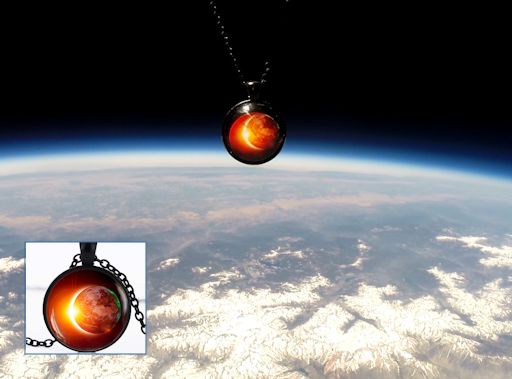
It's yours for $99.95. The students launched this pendant on July 17th. Floating at an altitude 105,000 feet above Earth’s surface, it made contact with space, experiencing temperatures as low as -63 C.
Buy the pendent now and for no additional charge we will fly it back to the stratosphere during the annular eclipse. Just make a note in the COMMENTS BOX of your shopping cart: "Fly my pendant again!"
Note: We have photographed the shadow of an eclipse before. Here's what the total eclipse of Aug. 21, 2017, looked like from the stratosphere over the Nebraska-Wyoming border:
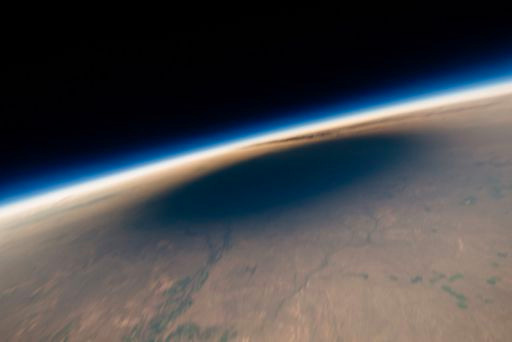
Total eclipses make deep black shadows, in this case blacking out more than 70 miles of terrain. What does the shadow of an *annular* eclipse look like? We hope to find out. It should be fuzzier around the edges, and not nearly as dark in the middle. An overview from the stratosphere could provide a unique picture.
Far Out Gifts: Earth to Sky Store
All sales support hands-on STEM education
Realtime Comet Photo Gallery
Free: Spaceweather.com Newsletter
Realtime Aurora Photo Gallery
Free: Spaceweather.com Newsletter
Every night, a network of
NASA all-sky cameras scans the skies above the United States for meteoritic fireballs. Automated software maintained by NASA's Meteoroid Environment Office calculates their orbits, velocity, penetration depth in Earth's atmosphere and many other characteristics. Daily results are presented here on Spaceweather.com.
On Sep 15, 2023, the network reported 12 fireballs.
(12 sporadics)
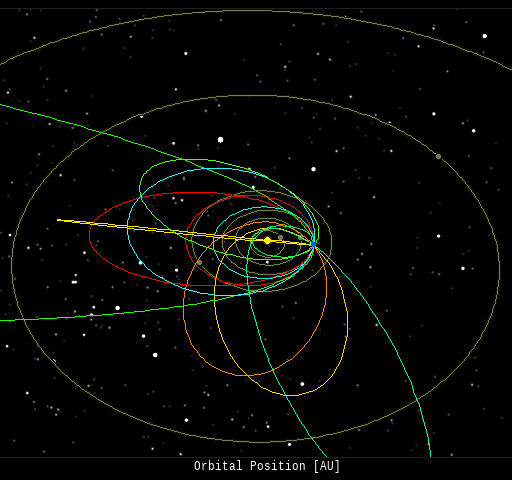
In this diagram of the inner solar system, all of the fireball orbits intersect at a single point--Earth. The orbits are color-coded by velocity, from slow (red) to fast (blue). [Larger image] [movies]
Potentially Hazardous Asteroids (
PHAs) are space rocks larger than approximately 100m that can come closer to Earth than 0.05 AU. None of the known PHAs is on a collision course with our planet, although astronomers are finding
new ones all the time.
On September 16, 2023 there were 2349 potentially hazardous asteroids.
 |
Recent & Upcoming Earth-asteroid encounters: | Asteroid | Date(UT) | Miss Distance | Velocity (km/s) | Diameter (m) |
| 2023 RU | 2023-Sep-11 | 10.6 LD | 20.3 | 26 |
| 2023 RK | 2023-Sep-11 | 15.9 LD | 9.4 | 24 |
| 2023 RG9 | 2023-Sep-11 | 14.9 LD | 5.7 | 26 |
| 2023 RC1 | 2023-Sep-12 | 3.1 LD | 5.1 | 6 |
| 2020 RT2 | 2023-Sep-12 | 11 LD | 10 | 8 |
| 2023 RO1 | 2023-Sep-12 | 6.6 LD | 12.4 | 22 |
| 2023 RR | 2023-Sep-13 | 17.4 LD | 21.2 | 49 |
| 2023 RH2 | 2023-Sep-13 | 11.3 LD | 21.5 | 58 |
| 2023 RR5 | 2023-Sep-13 | 0.5 LD | 13.8 | 6 |
| 2023 RC4 | 2023-Sep-13 | 13.1 LD | 7.6 | 17 |
| 2023 RA10 | 2023-Sep-14 | 3.5 LD | 4.2 | 6 |
| 2023 RZ7 | 2023-Sep-14 | 9.9 LD | 11.9 | 55 |
| 2023 RL6 | 2023-Sep-14 | 8.6 LD | 9.2 | 26 |
| 2023 RE5 | 2023-Sep-14 | 2.3 LD | 13.6 | 13 |
| 2023 RZ9 | 2023-Sep-15 | 13.1 LD | 5.8 | 15 |
| 2023 RO2 | 2023-Sep-15 | 7 LD | 6 | 10 |
| 2016 LY48 | 2023-Sep-16 | 5 LD | 10.8 | 99 |
| 2023 RY7 | 2023-Sep-16 | 13.7 LD | 11.1 | 26 |
| 2023 RM5 | 2023-Sep-16 | 11.5 LD | 9.5 | 19 |
| 2010 TE | 2023-Sep-16 | 6.8 LD | 6 | 22 |
| 2023 RQ9 | 2023-Sep-16 | 10.5 LD | 7.7 | 26 |
| 2023 RD13 | 2023-Sep-17 | 9.1 LD | 4.9 | 17 |
| 2023 RH11 | 2023-Sep-17 | 3.6 LD | 14.3 | 17 |
| 2023 RJ11 | 2023-Sep-17 | 14.9 LD | 6.8 | 21 |
| 2023 RO9 | 2023-Sep-17 | 13.2 LD | 12.3 | 24 |
| 2023 RV7 | 2023-Sep-18 | 10.7 LD | 19.9 | 34 |
| 2023 RV9 | 2023-Sep-18 | 10.1 LD | 7.2 | 41 |
| 2023 RK3 | 2023-Sep-19 | 18.8 LD | 9.6 | 42 |
| 2023 RV12 | 2023-Sep-20 | 9 LD | 6.6 | 21 |
| 2023 RP9 | 2023-Sep-20 | 2.3 LD | 13.2 | 29 |
| 2023 RA8 | 2023-Sep-20 | 15.5 LD | 6.6 | 27 |
| 523598 | 2023-Sep-20 | 19.8 LD | 25 | 239 |
| 2023 RR6 | 2023-Sep-21 | 15.5 LD | 7.5 | 14 |
| 2023 RQ6 | 2023-Sep-22 | 15.8 LD | 9.4 | 24 |
| 2023 RU3 | 2023-Sep-23 | 19.7 LD | 11.6 | 32 |
| 2019 SF6 | 2023-Sep-26 | 16.7 LD | 8.6 | 20 |
| 2023 RF3 | 2023-Sep-28 | 15.5 LD | 7.7 | 40 |
| 2013 TG6 | 2023-Sep-28 | 3.6 LD | 4.1 | 17 |
| 2023 RF9 | 2023-Sep-29 | 10.6 LD | 9.2 | 25 |
| 2009 UG | 2023-Sep-30 | 6.1 LD | 9 | 78 |
| 349507 | 2023-Oct-03 | 16.5 LD | 21 | 696 |
| 2022 FX1 | 2023-Oct-04 | 20 LD | 9.9 | 25 |
| 2019 QO5 | 2023-Oct-05 | 19.9 LD | 9.4 | 61 |
| 2023 RF10 | 2023-Oct-05 | 15.8 LD | 5.8 | 27 |
| 2023 QC8 | 2023-Oct-05 | 15.8 LD | 6.3 | 42 |
| 2022 TD | 2023-Oct-07 | 8.9 LD | 9.4 | 10 |
| 2018 ER1 | 2023-Oct-08 | 12.5 LD | 5.3 | 27 |
| 2022 UX1 | 2023-Oct-11 | 3.1 LD | 8.6 | 9 |
| 2023 RD11 | 2023-Oct-11 | 12.8 LD | 9.5 | 39 |
| 2015 KW120 | 2023-Oct-12 | 18.2 LD | 13 | 22 |
| 2021 NT14 | 2023-Oct-13 | 18.6 LD | 8.6 | 254 |
| 2011 GA | 2023-Oct-15 | 6.8 LD | 16.6 | 230 |
| 2007 SQ6 | 2023-Oct-15 | 19.4 LD | 6.5 | 130 |
| 2019 UZ3 | 2023-Oct-16 | 9.6 LD | 8.3 | 14 |
| 1998 HH49 | 2023-Oct-17 | 3.1 LD | 14.8 | 193 |
| 2022 UO10 | 2023-Oct-19 | 7.8 LD | 9.8 | 16 |
| 2020 UR | 2023-Oct-20 | 5.8 LD | 12.9 | 9 |
| 2020 FM6 | 2023-Oct-23 | 15.5 LD | 15.9 | 149 |
| 2019 HH4 | 2023-Oct-24 | 13.3 LD | 20 | 365 |
| 2023 RA4 | 2023-Oct-24 | 8.4 LD | 3.9 | 49 |
| 2021 SZ4 | 2023-Oct-26 | 14 LD | 30 | 287 |
| 302169 | 2023-Oct-26 | 12.7 LD | 25.7 | 374 |
| 525229 | 2023-Oct-30 | 10.6 LD | 17.4 | 200 |
| 2013 UV3 | 2023-Nov-01 | 14.7 LD | 15.4 | 16 |
| 2016 WY | 2023-Nov-02 | 9.1 LD | 3.9 | 5 |
| 363505 | 2023-Nov-02 | 13.7 LD | 8 | 709 |
| 2022 JF | 2023-Nov-03 | 15.2 LD | 17.2 | 39 |
| 2023 QP8 | 2023-Nov-03 | 17.1 LD | 8.8 | 174 |
| 2016 VW2 | 2023-Nov-03 | 10.1 LD | 8.1 | 20 |
| 2019 UH7 | 2023-Nov-04 | 9.9 LD | 5.9 | 11 |
| 2014 BA3 | 2023-Nov-13 | 15.7 LD | 2.7 | 8 |
Notes: LD means "Lunar Distance." 1 LD = 384,401 km, the distance between Earth and the Moon. 1 LD also equals 0.00256 AU. | | Cosmic Rays in the Atmosphere |
SPACE WEATHER BALLOON DATA: Almost once a week, Spaceweather.com and the students of Earth to Sky Calculus fly space weather balloons to the stratosphere over California. These balloons are equipped with sensors that detect secondary cosmic rays, a form of radiation from space that can penetrate all the way down to Earth's surface. Our monitoring program has been underway without interruption for 7 years, resulting in a unique dataset of in situ atmospheric measurements.
Latest results (July 2022): Atmospheric radiation is decreasing in 2022. Our latest measurements in July 2022 registered a 6-year low:
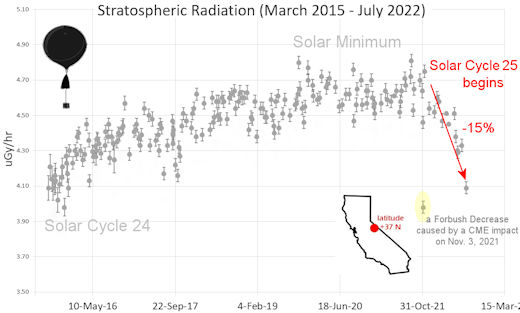
What's going on? Ironically, the radiation drop is caused by increasing solar activity. Solar Cycle 25 has roared to life faster than forecasters expected. The sun's strengthening and increasingly tangled magnetic field repels cosmic rays from deep space. In addition, solar coronal mass ejections (CMEs) sweep aside cosmic rays, causing sharp reductions called "Forbush Decreases." The two effects blend together to bring daily radiation levels down.
.Who cares? Cosmic rays are a surprisingly "down to Earth" form of space weather. They can alter the chemistry of the atmosphere, trigger lightning, and penetrate commercial airplanes. According to a study from the Harvard T.H. Chan school of public health, crews of aircraft have higher rates of cancer than the general population. The researchers listed cosmic rays, irregular sleep habits, and chemical contaminants as leading risk factors. A number of controversial studies (#1, #2, #3, #4) go even further, linking cosmic rays with cardiac arrhythmias and sudden cardiac death.
Technical notes: The radiation sensors onboard our helium balloons detect X-rays and gamma-rays in the energy range 10 keV to 20 MeV. These energies span the range of medical X-ray machines and airport security scanners.
Data points in the graph labeled "Stratospheric Radiation" correspond to the peak of the Regener-Pfotzer maximum, which lies about 67,000 feet above central California. When cosmic rays crash into Earth's atmosphere, they produce a spray of secondary particles that is most intense at the entrance to the stratosphere. Physicists Eric Regener and Georg Pfotzer discovered the maximum using balloons in the 1930s and it is what we are measuring today.
| | The official U.S. government space weather bureau |
| | The first place to look for information about sundogs, pillars, rainbows and related phenomena. |
| | Researchers call it a "Hubble for the sun." SDO is the most advanced solar observatory ever. |
| | 3D views of the sun from NASA's Solar and Terrestrial Relations Observatory |
| | Realtime and archival images of the Sun from SOHO. |
| | information about sunspots based on the latest NOAA/USAF Active Region Summary |
| | current counts of failed and deployed Starlink satellites from Jonathan's Space Page |
| | Authoritative predictions of space junk and satellite re-entries |
| | from the NOAA Space Environment Center |
| | fun to read, but should be taken with a grain of salt! Forecasts looking ahead more than a few days are often wrong. |
| | from the NOAA Space Environment Center |
| | the underlying science of space weather |
 | When looking for casinos to play online when the weather is bad, you can try casino online trucchi for Italian games. If you are not from Finland you can try the Swedish page Svenska casino online to find suitable games, check out svenskacasinoonline.net. Always check your local laws before playing with real money. |
 | BestCSGOGambling is the best site for everything related to CSGO gambling on the web |
| | These links help Spaceweather.com stay online. Thank you to our supporters! |
| | | | | | |

